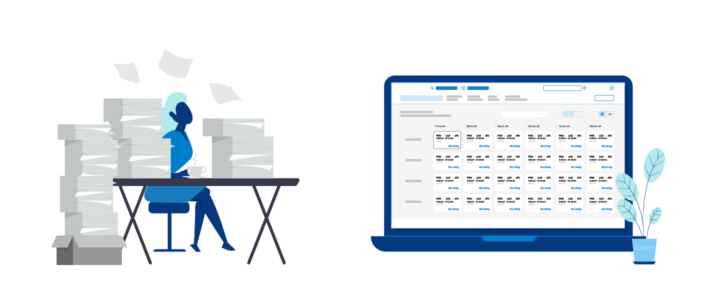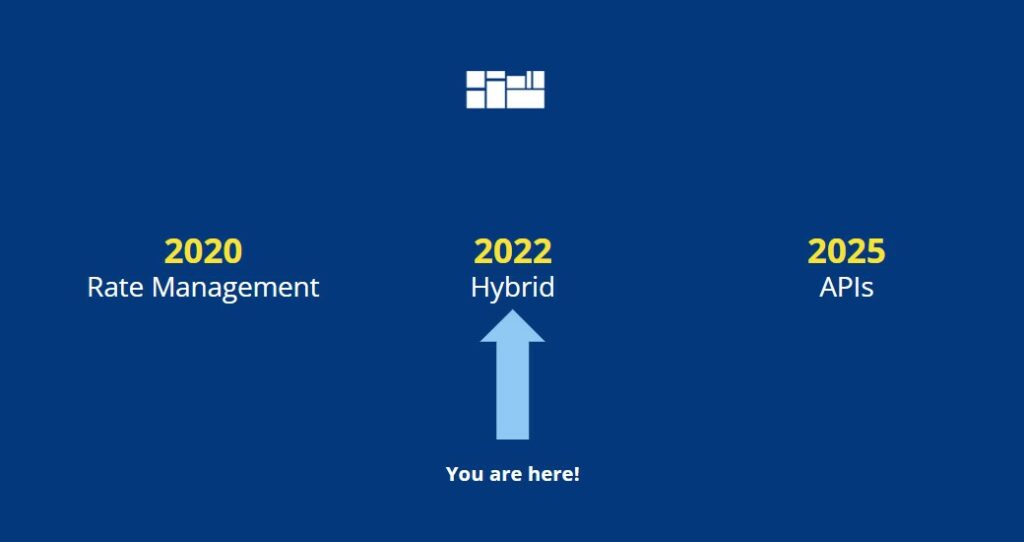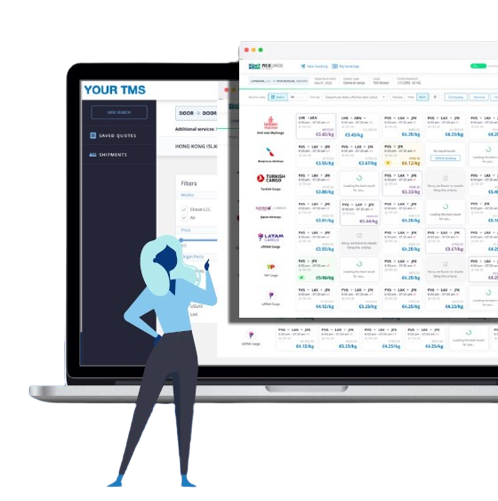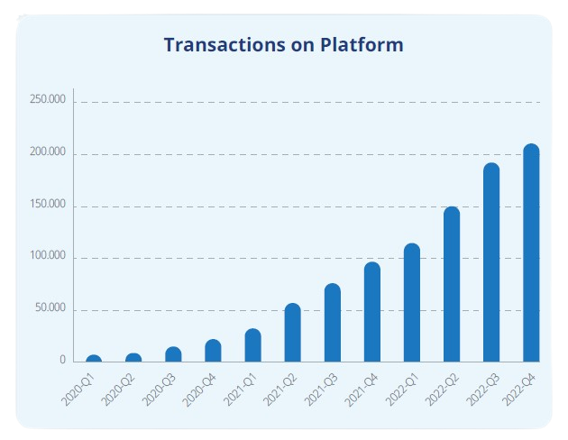The Changing Face of International Freight Rate Management in 2023 | Part II

In this article, you’ll discover:
- Why rate management, quoting, and sales tools must adapt to thrive
- Five essential features for powerful RFPs
Adapt or Lose Business: The ultimate call for rate management, quoting, and sales tools to modernize
Let’s start with the practical ramification of API integrations when it comes to freight pricing, quoting and booking. The most important aspect is, of course, combining the power of a rate management and quotation tool that can take static rates with real-time pricing and sailing dating, enabling the comparison of contract rates, against spot rates helping forwarders optimize shipping options, then making those available to the customers.
In the Hybrid Era of 2023, Two Types of APIs Are Necessary
It’s important to recognize that today, in 2023, both static rate sheets and real-time API pricing live in parallel. Airlines that represent some 50% of all global capacity are available for booking online and some airlines report 60%+ of their spot bookings on their own website but by many estimates, the vast majority of air cargo bookings are still done offline and, most likely, based on static rates. This makes 2023 until 2025 or even 2030 a transition period. In order to cross the chasm between pure rate management and obtaining quote-building information via APIs alone, two types of APIs are necessary during this transition period:
- APIs that provide the ability to access carrier rates
Carriers are making APIs to show the availability of capacity and pricing. Third party platforms have a hub, allowing them to access those airline rates instantly through APIs, to be able to search on a particular load and instantly understand where there’s available capacity and pricing. This, of course, can then be further broken down into market APIs and contract rate-specific APIs.
- APIs that provide the ability to connect to another system – eg. a TMS – or another customer portal
These APIs allow forwarders to connect their rate management systems to their TMSs or their rate management systems to their sales portals, all still with API access to rates from the over 50% of global air cargo capacity available online.
How are cargo APIs changing?
API connections are key to staying ahead in the freight forwarding game. As WebCargo’s CEO, Manel Galindo, puts it:
“With the capacity and APIs available on third party booking platforms like WebCargo, I think that the information we are giving to freight forwarders is really competitive, and that’s why we see more and more forwarders choosing to book for free through our platform.
And of course, they now have confidence in online pricing, that perhaps three years ago they didn’t have, when they wanted to call the airline to see if they could get a better price. But now they understand that what they will get online is the same price they would get offline.”
Integrating eBooking with quoting from traditional contract rates is a vital bridge during this transition period. However, the real time savings come from platforms like WebCargo, that provide APIs which build those into quotes that forwarders can instantly share with their customers, slashing the quoting time for salespeople by 20x.
[optin-monster slug=”yr5zjyq9wdg11ajigp5n” followrules=”true”]
…easy as 1, 2, 3
Whether it’s by connecting to WebCargo via API, or booking directly on the WebCargo interface, the operational streamlining provided by WebCargo’s variety of APIs to help forwarders navigate this hybrid world can be boiled down to three easy steps:
- The ability to take a spot booking and make it available right away, allows forwarders to effortlessly quote to customers, letting forwarders book up to 80% faster.
- Automating the booking to enable forwarders to book using APIs from their TMSs as needed, to avoid needing to exit their own integrated systems.
- Providing APIs for booking management, so that once something’s booked, all the documents are automatically exchanged, with track and trade traces available through APIs.
These API integrations allow forwarders to price, book and manage shipments end-to-end, without ever even picking up the phone or sending an email, saving up to one hour per team member per day.
This level of transparency provided by API connections results in a 20x improvement in booking time for forwarders, and has meant a record 150+K eBookings placed with WebCargo’s booking platform in Q3 of 2022 alone!
API capabilities also generate data that contribute to improved business intelligence – including faster and better-informed pricing decisions for forwarders. The ability to quickly update prices based on real-time changes to capacity and schedules also provides new pricing and utilization opportunities. And for carriers, as digitized rates often mean more centralized pricing controls, airlines are also seeing improved margins based on firmer pricing.
In plain English, APIs make sure that everybody can do their best job. They avoid forwarders having to run around getting pieces of paper and numbers. All of the information is available through the systems they use every day, in a completely streamlined and instant way.
[optin-monster slug=”nvollmsowpqb3f8incft” followrules=”true”]
5 Essential Features to Supercharge a Forwarder’s RFPs
APIs and integrations might be nice buzzwords, but won’t necessarily help forwarders understand what they need in practice when building out rate management, quoting and eBooking systems.
So without further ado, here are the top 5 features to watch out for:
- Multimodal Quote-building
The pandemic brought major disruption to the supply chain, causing a scarcity of capacity and logistical chaos. In response, forwarders have had to adapt by moving cargo that typically went by sea via air and vice-versa, while also often working remotely due to COVID restrictions.
This has made it crucial for forwarders to have a system to compare and quote across multiple modes, while maintaining a consistent brand image for customers. With WebCargo’s platform, forwarders can protect their brand and simplify the quoting process by offering quotes across multiple modes in a way that makes sense for their customers in a unified platform.
As importers and exporters begin to seek more control over their procurement habits, forwarders can differentiate by providing easy and on-demand mode comparisons. With a good rate management system, forwarders can quickly generate detailed, comprehensive customer quotes from multiple pricing sources and modes. Providing customers with “ready-to-go” quotes quickly goes a long way in providing customers with an exceptional customer experience.
- Static and Dynamic Rate Management
2023 is a hybrid world. Airlines are providing rating and capacity information via APIs as opposed to through Excel sheets or PDFs. However, a significant chunk of carriers in the market have not yet digitized and are still doing things the old-fashioned way.
This means that when shopping for a rate management tool, freight forwarders need one that will allow them to effectively quote using different types of pricing – both the dynamic rates and the static ones from the Excel sheets and the PDFs that everyone loves to hate.
Good rate management systems will be able to combine the different rate types to show forwarders all their options – consolidations, long term contracts and spot rates – and easily convert these into a simple quote for the customer.
In a post-pandemic era where rates and available capacity can change within minutes, on top of managing pricing from contract sheets, market tariff or promotional rates, forwarders need to be able to convert the live rates on the platform into a customer quote in real time.
With more sophisticated rate management systems like that from WebCargo, those rates would continue to update automatically up until the moment the customer opens the email quote, with the shipper able to confirm and place the eBooking at a click within the email.
Closing that gap between when a freight forwarder secures a rate from a carrier and when they offer it to the customer is crucial. Once the customer can accept and book the rate, everything becomes easier. Transparency is increased, and headaches for forwarders, carriers, and shippers are reduced.
- Data procurement
Forwarders need access to data, and they need it yesterday. Rate management systems and quotation tools sit on top of data, with forwarders using them to build the most cost-effective and data-accurate quotes for their customers. When individual team members calculate quotes themselves while relying on multiple rate sheets and over a dozen surcharges, it increases the chances of expensive inaccuracies that can increase quoting time by well over 5%, not to mention the invoice reconciliation headaches this generates.
Forwarders manually pulling quotes end up in a tangled mess of rate sheets, PDFs, and Excel sheets, managing complex tariffs and their surcharges – not to mention the additional cost of hiring pricing managers. The instant rate-search and quotation enabled by the data pulled from a rate management system, means the time saved by a sales team can increase team efficiency by as much as 86%, with fewer errors, better data accuracy, and less manpower required compared to building quotes manually.
See how Scan Logistics supercharged their operational efficiency with data from WebCargo’s rate management and quoting tools.
- Meeting forwarders where they are
Front end portals that forwarders can log into to find information and quote to customers are useless without data servicing that portal in the back end. Keeping pricing and capacity up-to-date in a world where rates and pricing can change from one minute to the next is nearly impossible, unless you have the right rate management platform in the background to support it.
This means that rate and quotation management platforms need APIs available to feed the front end. A more sophisticated third party platform like WebCargo therefore also builds up a front end that sits directly on top of its rate management and quotation platforms, providing seamless procurement all the way through – from how forwarders gather information, to how they put it in front of a customer, and how they then book that freight.
- Integration
Forwarders don’t need one tool that solves it all. They need the right tools that all integrate. When moving a single piece of cargo from point A to point B, there could be up to 28 different parties touching that shipment along the way, each one having their own systems. Therefore, having the right tech stack with APIs to connect data – everything from the carrier to the forwarder’s rate and quotation management system, to the sales portal that their customers are interacting with, to the TMSs where shipments are actually executed, to the accounting softwares that takes care of the invoicing – is paramount.
The magic all starts with API integration. The data can then flow to provide better transparency, with a lower risk of error, and of course, being able to make more intelligent, accurate pricing and booking decisions faster than ever before.
With API integration, forwarders can quickly generate detailed, comprehensive customer quotes from multiple pricing sources and modes. Providing customers with “ready-to-go” quotes quickly goes a long way in delivering an exceptional customer experience. And – especially when combined with a customer-facing online sales channel – this has been shown to increase win rates by up to 5%.
The Takeaway for 2023…and beyond
Those five components are something forwarders should be looking at when figuring out how they’re going to weather 2023, 2024, and beyond.
Finding a rate management system, quotation tool and booking platform in a single, unified system is key to maintaining 24/7 operations – not just 24-hour sales – but actual operations, including weekends.
The level of customer service this unlocks makes a huge difference to the bottom line, when being able to design a customer journey where forwarders can reliably capture all the essential information for a booking and create a flawless process for the user. It’s precisely this superior user experience for forwarders and their shipper customers that ultimately helps to close more sales and increase revenue.




